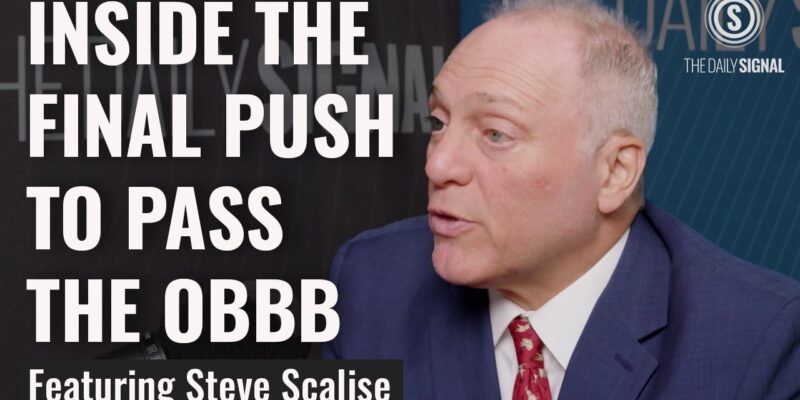It was an incredibly hectic and high-stakes 48 hours as House leadership cobbled together the votes to send the One Big Beautiful Bill Act to President Donald Trump’s desk.
Few, if any, are better positioned to discuss what happened in those pivotal moments than House Majority Leader Steve Scalise. He joined “The Signal Sitdown” to give a behind-the-scenes look at the final push to pass the “One Big, Beautiful Bill” at a media row event hosted by the Republican Study Committee on Capitol Hill Tuesday.
After six weeks of negotiations, the Senate needed the help of Vice President JD Vance. Vance cast the tie breaking vote in the upper chamber to send the One Big, Beautiful Bill back to the House just three days before the president’s self-imposed deadline of July 4.
Because of Republican’s narrow margins in both chambers, “we were always on a razor’s edge with this bill,” Scalise told The Daily Signal. When Vance had to break the tie in the Senate, “it showed you just how narrow these margins are.”
But the bill that returned to the House from the Senate had some key differences from the product the House originally passed in May. The Senate made larger reforms to Medicaid, changed certain energy subsidy provisions, and tweaked a few other things. But the biggest sticking point for conservatives in the House was the lower amount of government spending cuts relative to tax cuts and the impact that would have on government deficits and debt.
“When the bill came back from the Senate, they made a few changes: some good, some bad. … [The House] had to weigh all of that,” Scalise said. The bigger determining factor for Scalise and other House Republicans, however, was one question: “Does it achieve all the things that President Trump and House Republicans wanted to achieve at the beginning?”
“Failure was not an option,” Scalise told The Daily Signal. “If Congress did nothing, then you would’ve had the largest tax increase—four and a half trillion dollars—primarily hitting middle- and low-income families.”
Those priorities, Scalise said, were “no tax increases, no tax on tips, no tax on overtime,” among others. Scalise also seemed to suggest the Senate changes to the bill have been overblown. “Over 85% of the items that were in the House version ended up in the final version that came back to us,” he noted. “So there weren’t a lot of changes made in the Senate.”
“Some, I would argue, were better changes,” Scalise added. For example, he pointed to “limiting the provider tax, which is a money-laundering scheme that even President [Barack] Obama and President [Joe] Biden said needed to be reformed. President Trump said we needed to reform that, too, and that ended up being in the bill.”
To Republicans who wanted to make deeper cuts to government spending, Scalise argued the bill makes “historic cuts, by the way, in waste, fraud, and abuse in government: $1.6 trillion in cuts to waste, fraud, and abuse. The record for any Congress before that was $800 billion, even adjusted for inflation. So we more than doubled the historic record of cuts.”
House members also said they felt they were getting jammed with the Senate’s version of the bill with little time to review, discuss, and publicly debate those changes. In the past few years, House members have pushed for at least 72 hours to scrutinize a piece of legislation before it is brought to the floor for a vote.
Scalise told The Daily Signal that “anybody that wanted to read the bill had an opportunity.”
“In fact, the Senate read the bill. They had a reading of the entire bill—900 pages—on the Senate floor that took about 14 hours,” Scalise said. “So anybody that said, ‘Oh, I need time to read the bill,’ they had that opportunity.”
“You had more than enough time to read the entirety of the bill, and it was read in its entirety on the Senate floor. By the time it came back, you knew the changes that were made,” Scalise added.
“There were maybe some items we’d like to make a little bit better, but at the end of the day, you also need the votes to pass the bill,” Scalise said, addressing some conservative critiques.
“You know, if I wrote it on my own, it would look different, just as if you wrote it on your own,” he explained. “But that bill wouldn’t have gotten to President Trump’s desk because in the House you need 217 other people to agree with you and in the Senate you need 49 other people to agree with you and then get JD Vance to break the tie.”
It was a hard sell, but successful. “We said, ‘Look: Yes, we can get this bill to the president’s desk and still hit every target we set out to achieve,’” Scalise recalled.
Trump was the One Big, Beautiful Bill’s not-so-secret weapon. “I love working with President Trump,” Scalise said. “Nobody’s more engaged in the legislative process.” The president was intimately involved in making sure Republicans had the votes so he could sign the legislation on July 4.
“President Trump made phone calls, brought people to the White House,” Scalise told The Daily Signal. “When there were problems with the vote coalition, he just called: ‘Steve, give me names.’ And he called all of those members—you don’t want to be on the other end of that call, by the way.”
In short: “President Trump knows how to close the deal,” and he did.
“Nobody thought that could happen,” Scalise stated. “In a narrow group of majorities, we delivered on some of the most historic wins for the American people.”
“We’ve got a great bill to go sell now, and we’re gonna see economic growth like we haven’t seen,” Scalise said, previewing the 2026 midterm elections.
“This bill’s going to deliver a lot of big wins for hardworking families,” the majority leader told The Daily Signal. “President Trump said in the campaign on every stop, we’re going to have no tax on tips, we’re going to have no tax on overtime. We delivered on those promises as well in the One Big, Beautiful Bill.”
“Think about a tip worker, you’re at a restaurant, waiter, waitress that serves, and, on average, they make about $32,000 a year,” Scalise explained. “No tax on tips means about $1,700 more in their pocket. It’s real money for working families.”
“No tax on overtime? Same thing,” Scalise continued. “You know, a shift worker at a local plant making things in America won’t have to pay taxes on overtime. But that also means your local nurses at a hospital, your police officers… now, when they’re working extra hours away from their family, they won’t be paying taxes on overtime. This is gonna get the economy moving again.”
Scalise named some metrics for the American people to watch as they evaluate the effects of the One Big, Beautiful Bill. “You’ll see inflation come down, interest rates come down. That first time home buyer can actually go out and buy a home again. They couldn’t do that under Joe Biden and his economy and the Democrats were against all of it.”
“Every Democrat voted to raise taxes on every family in America,” Scalise concluded. “And it’s going to be a great contrast. Your Democrat opponent was against all of these reforms. They wanted higher taxes, they wanted more government control. We wanted to put more power back in the hands of families and more money back in the pockets of families.”
Bradley Devlin is politics editor for The Daily Signal.
Advertisement
Advertisement

